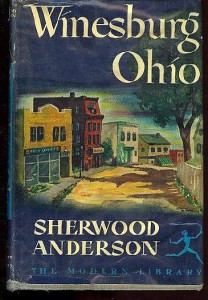 Whatever the path, I’m glad I took it because Anderson truly pained a fascinating picture of pre-World War I life in the heart land with his book, named to Modern Library’s 100 Best Novels list in in 1999.
Whatever the path, I’m glad I took it because Anderson truly pained a fascinating picture of pre-World War I life in the heart land with his book, named to Modern Library’s 100 Best Novels list in in 1999.
The best part of the collection, for me, was the ability to jump in and out as I pleased. I read Winesburg over more than a month so the lack of central narrative actually played in its favor.
Each chapter (or story since it really is a collection of short stories) focuses on a different person in the town. Within these 22 stories, several characters pop up more than once, but the focus always changes. This allows you to wade in and out of life in Winesburg as you please, especially due to the simple nature of the prose.
Anderson doesn’t try to do too much, which allows his many characters to dominate the story. The author doesn’t overwhelm with description or dialogue. The easy pace reflects a much easier time. My only regret is that I did not have a map of the fictional town available as a reference since I had the Kindle version.
I had never heard of him before picking up (or downloading as was the case) this book so I’m intrigued to read some of his other work. I had no idea Anderson served as an influence for writers such as Hemingway, Steinbeck and Faulkner. I may end up disappointed, but at least I found one new book I could enjoy.

Reading it (or I should say, listening the audiobook) now. Interesting to see how this is the predecessor to Garrison Keillor’s Lake Woebegone and Tom Bodett’s The End of the Road. I wonder if Winesburg was the first novel of this style, to focus on just one small community and explore its characters?
Anyways, good blog post and thanks for the link to the map!
I justfinished this collection of tales: I see how one can wade in and out as each story could be standalone, but I found the cummulative effect of the tales more potent than each one in isolation. Each story seemed to build up on the atmosphere and narrative of the one before. Goos review, btw.